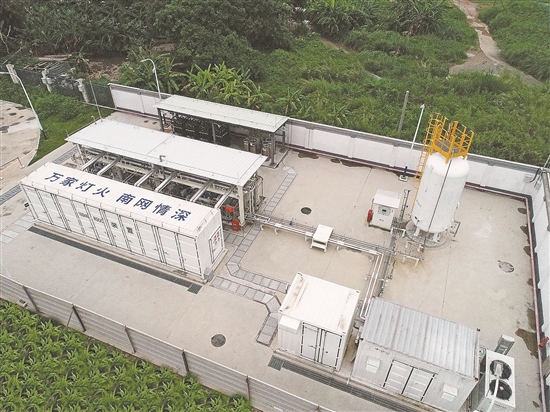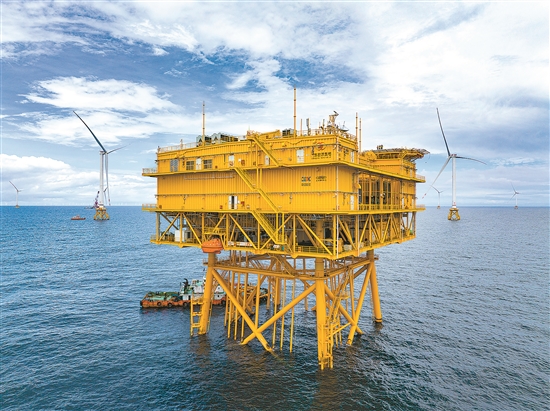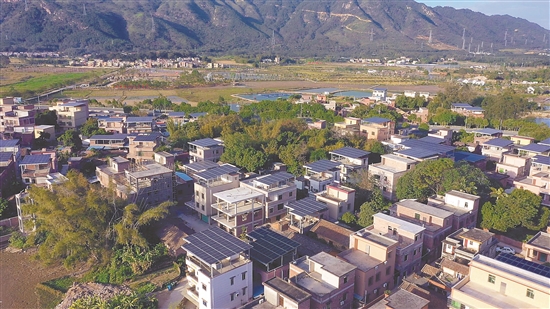
As an economic and manufacturing powerhouse, Guangdong has achieved significant success in the new energy sector. Emerging clusters in cutting-edge fields such as new energy storage are injecting fresh vitality intothe industrial economy.
China's first bidirectional energy storage system launched in Guangzhou
In June 2024, China's first 100-kilowatt-level electric-hydrogen bidirectional conversion device, capable of both hydrogen production and power generation, was launched in Guangzhou. This device enables efficient bidirectional conversion between green electricity and clean hydrogen, marking the transitionof China's reversible solid oxide fuel cell technology from the laboratory to practical demonstration.
The "Made in Guangdong" device achieves minute-level conversion between electricity and hydrogen, reaching the forefront of international and domestic standards. By the end of the 15th Five-Year Plan period, this technology is expected to be further applied in industries such as metallurgy and chemical engineering, with the scale of electric-hydrogen conversion set to increase by a hundredfold to the megawatt level.

Also in Guangzhou, Yuntao Hydrogen Energy, a company established just two years ago, has already achieved complete domestic production of six out of eight core components for its hydrogen fuel cell engine systems. A heavy-duty dump truck utilizing hybrid hydrogen fuel cells and lithium batteries has achieved a cruising range of 350 to 400 kilometers.
By collaborating with 20 key component companies and research institutions along the industry chain, Guangzhou has established China's first hydrogen fuel cell industry innovation consortium. This collaboration aims to reduce costs and increase efficiency across the industry chain, accelerating the large-scale application of hydrogen energy and fuel cells.
The rise of hydrogen energy is just one facet of Guangdong's integrated new energy sector. In 2022, the operating revenue of Guangdong's new energy industry cluster reached approximately 710 billion yuan, with an installed power generation capacity of 86.05 million kilowatts.
According to the "Action Plan for Cultivating Emerging Industry Clusters of New Energy Strategic in Guangdong Province (2023-2025)", Guangdong's new energy industry has a solid foundation and strong competitiveness. The province boasts significant advantages in marine energy, geothermal energy, biomass energy resources, and technology, as well as abundant port resources and potential marine oil and gas resources. Guangdong's strong manufacturing base and strengths in the electronic information industry also provide robust support for the enhancement of new energy manufacturing and industrial integration.
"Guangdong Energy" ready for the future
In recent years, Guangdong's new energy industry has continued to expand. Wind energy, solar energy, and biomass energy have achieved large-scale applications, with the province leading the country in nuclear power installed capacity and natural gas storage. Offshore wind power is also on a fast track for development.
In Yangjiang, Guangdong, the Qingzhou No.1 and No.2 offshore wind power projects have launched the world's first 500 kV AC offshore step-up station, the world's first 500kV three-core submarine cable, and China's first wind farm with batch applications of 11MW turbines. Additionally, the Yangjiang Shaba Offshore Wind Power Project has completed the world's first embedded rock tripod jacket wind turbine foundation.

In Qingyuan City's Yuantan Town, Guangdong's first "carbon-neutral" new energy demonstration village, Xinma Village, has seen 250 households sign rooftop photovoltaic cooperation agreements, accounting for nearly 30% of the village's total households. The rooftop photovoltaics not only provide self-sufficient electricity but also generate additional income for the villagers annually.
According to the "Action Plan for Cultivating Emerging Industry Clusters of New Energy Strategic in Guangdong Province (2023-2025)", by 2025, Guangdong's new energy industry is expected to achieve an operating revenue of over 1 trillion yuan, with an added value exceeding 200 billion yuan. The installed power generation capacity of the new energy industry cluster is projected to reach approximately 144.3 million kilowatts, with natural gas supply capacity exceeding 80 billion cubic meters and hydrogen supply capacity surpassing 100,000 tons.
Source: Yangcheng Evening News
你所不知的“广东能”
作为经济大省和制造大省,广东在新能源产业硕果累累,新型储能等领域则涌现出一批全国领先细分产业集群,激发工业经济新活力。
“中国首套”双向储能在穗投运
今年6月,“既能制氢,又能发电”的我国首套百千瓦级电氢双向转换装置在广州投运。它可实现“绿电”与“绿氢”双向高效转换,标志着中国可逆固体氧化物电池技术从“实验室”走向了“示范应用”。
据了解,这套“广东造”装置电和氢的转换过程达到分钟级,处于国际先进、国内领先水平。预计到十五五期间,该技术将进一步应用于冶金、化工等行业领域,电氢转换规模将提升百倍,拓展到万千瓦级。
同在广州,成立仅2年的云韬氢能氢燃料电池发动机系统的八大核心零部件中已有六个实现了完全国产化。一台采用了氢燃料电池和锂电池混合技术路线的重型自卸车,续航里程已经“轻松”达到了350公里至400公里之间。
通过联合产业链上下游20余家核心零部件企业和科研院所,广州组建全国首个氢燃料电池产业创新联合体,推动产业链共同降本增效,加速推进氢能和燃料电池的规模化应用。
氢能“雄起”只是广东新能源产业“珠联璧合”的一环。数据显示,2022年,广东新能源产业集群营业收入约7100亿元;新能源产业集群涉及的发电装机规模8605万千瓦。
根据《广东省培育新能源战略性新兴产业集群行动计划(2023-2025年)》,目前,广东新能源产业已具备较好的发展基础和较强的竞争能力,海洋能、地热能、生物质能资源和技术优势突出;港口资源和海洋油气潜在资源丰富;广东良好的制造业基础和电子信息产业优势,为新能源制造业提升、产业融合发展提供了有力的支撑。

“广东能”面向未来蓄势待发
近年来,广东新能源产业规模不断壮大。风能、太阳能、生物质能实现规模化应用,核电装机规模、天然气储备能力全国领先,海上风电进入快速发展通道。
在广东阳江,青洲一、二海上风电项目投运了全球首座500kV海上升压站,全球首根500kV三芯海缆,全国首个批量化应用11MW风机风电场,依托阳江沙扒海上风电项目完成了国内乃至世界首个完工的植入嵌岩三桩导管架风机基础。
在清远源潭镇,广东首个“碳中和”新能源示范村新马村,村里已有250户村民签订了屋顶光伏合作协议,占全村总户数的近三成。屋顶光伏除了让村民用电自给自足,还可以每年增收。

根据《广东省培育新能源战略性新兴产业集群行动计划(2023-2025年)》,预计到2025年,广东新能源产业营业收入超过1万亿元,增加值超过2000亿元;新能源产业集群涉及的发电装机规模约14430万千瓦,天然气供应能力超过800亿立方米,供氢能力超10万吨。
总策划:杜传贵 林海利
总统筹:孙爱群 吴江
统筹:孙晶 刘佳宁
文丨记者 王丹阳 董鹏程
图丨受访者提供
翻译丨郑圣浩
-
Ylog|Zero bad review of Xinjiang, what's good about it? 零差评的新疆,好在哪?
2024-06-30 21:56:59 -
First 'Guangdong-born' beluga whale calf of the year born
2024-06-30 20:55:53 -
Viewing the China-Eurasia Expo: Connecting China with various Eurasian countries, Xinjiang holds a significant position
2024-06-30 21:28:15 -
Interview with builders: Shenzhen-Zhongshan Link's technological breakthrough
2024-06-30 21:28:29






